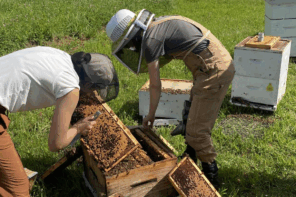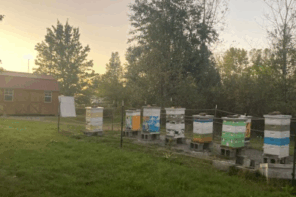Time Travel
By: Ed Colby
The road to my billionaire’s bees was buried in nearly a foot of snow, virgin but for a couple of pickup tracks. It somehow didn’t look that deep to me. So of course, I got my all-wheel-drive Subaru Outback stuck. I have great snow tires, but it looked hopeless nonetheless because it was uphill all the way back. While I alternately kicked myself and searched for my AAA card for a tow, my beekeeping mentee Megan and my billionaire’s gal – Friday Maria shoveled out my wheels.
Finally Megan said, “Get in, turn this thing around and drive out of here!” This was not going to work, but I had no other options, so I did what she told me, and guess what?! I drove right out.
You see? Sometimes we just need a little help from our friends. I learned this when I was president of the Colorado State Beekeepers Association. I’d find myself in some seemingly intractable situation, and I’d throw up my hands and call Tina. She almost always had a workaround, or a radically different approach, and together we’d charge ahead into the fog. Two heads are almost always better than one.
After we got unstuck, Megan and I started popping hive lids and checking honey stores. Pretty soon a snow plow truck roared by. Megan said, “How’d they get a plow here so fast?” to which I replied, “Billionaires generally receive excellent service!”
This particular billionaire owns five colonies, down from seven last Fall, when Varroa mites had their way with three of them. I got the mite numbers down before Winter, but not before most of the bees in those three hives died. I rolled the survivors into one hive, queens and all, because I couldn’t see any prospect of overwintering four-framers weakened by Varroa-induced viruses.
And now? All five remaining colonies look great, even that combination hive. That’s a colony I need to re-queen. But I failed to mark it, and I can’t remember which one it is. I guess I’ll have to re-queen ‘em all, which might not be such a bad thing. But there’s a lesson here: Keep better records than I do.
It feels weird writing to you today, in early March, since you won’t read these words until May. By then my billionaire’s snow should be gone, and if all went according to plan, those colonies all got re-queened. But you can’t know this for sure. In beekeeping, everything changes constantly, and with the publishing time lag, “today” is never really today. This makes me feel like a time traveler.
I expect to receive my first shipment of Carniolan queens in mid-April, with a second two weeks later, and then some Russians in late May. My re-queening strategy:
- From my strong colonies, i.e. those with both brood supers more or less full of brood and bees, make splits or pull nucs. Re-queen the mother colony if its queen is more than a year old.
- Re-queen colonies not strong enough to split or nuc.
- As for weaker colonies, say eight or fewer frames of bees on May 1, execute their queens (like Mary, Queen of Scots!) and combine these bees with another hive, or simply re-queen them.
Not all queens survive in a new hive, and in the past, this made me reluctant to replace perfectly good old queens with unproven new ones. But beekeeping’s a gamble. Plus, a hive that rejects its new monarch is not necessarily doomed. It will most likely make a new queen all on its own, and the ensuing broodless period creates a break in the Varroa mite reproduction cycle. And if natural re-queening fails? All’s not lost. Simply add these bees to a colony that could use some help.
What I most like about new queens is their extraordinary reluctance to swarm. With this problem out of the way, powerful newly queened hives can get started early and fill lots of honey supers.
Now, powerful colonies that produce lots of honey also produce lots of mites. This is why your best hives are the ones that crash in the Fall, when mite numbers are still on the increase, just as honey bee populations naturally decline.
My new strategy is to hit the mites before they get the upper hand. The little monsters are about impossible to test for in the Spring when they’re reproducing under the brood cappings and not out in the open where you can count ‘em. So, instead of waiting for Varroa to show up in my mite tests in June, this year I’ll hit all my colonies with an early mite treatment – like oxalic acid for broodless colonies, or – for colonies with brood – Apivar (amitraz), Formic Pro (formic acid), or Apiguard (thymol). All depends on the temperature, whether I have honey supers on my hives and what treatments I have on hand.
This isn’t the way I want it to be. I’d rather treat only those colonies that absolutely need it, and leave the rest. But I’ve got 75 hives, no help, and there’re only 24 hours in a day. Plus I’m old, and I sometimes take naps in my out yards. The bees buzz me lullabies, the little darlings! So I’m not that efficient on the job. But all the while, Varroa keep sneaking up on me. One way or another, this has to stop.
Gentle reader, did you find this piece amusing, heartwarming, even instructive? If you’d like to read more of Ed Colby’s beekeeping adventures and misadventures, contact him at Coloradobees1@gmail.com. Ask him to promptly mail you an attractive signed copy of A Beekeeper’s Life, Tales from the Bottom Board. Price: $25. Satisfaction guaranteed or your money back!









